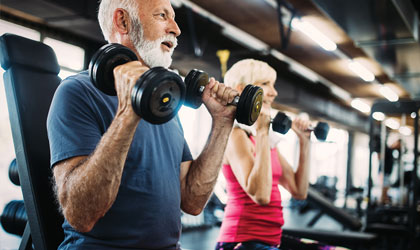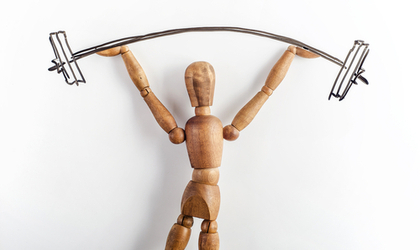
The words idle and inert may spring to mind when you think about your bones. In reality, though, your bones are nothing of the sort; they’re living and active tissues, constantly adapting to the strains and stresses of modern day life. If you’re slumped at your desk all day, trudge onto the bus home, and then crash on the sofa, your bones will respond – and boy, they won’t be happy about it. Unlike inactivity, your bones love movement, much like the rest of your body). In fact, when it comes to bone health, moving more is one of the best weapons going. Weight bearing exercise, strength training, and flexibility practises are powerful tools to fortify bones and counter the effects of aging or hormone-related changes (side note: bone strength starts to decline by 1% per year after the age of 40). Here’s why working out should be part and parcel of your bone-bolstering regimen.
Weight-bearing exercise
Weight bearing exercise has earned its stripes as a stellar option for bone health thanks to it stimulating extra calcium deposits and nudging osteoblasts – cells that promote bone growth – into action. The result: stronger, denser bones. In one study, 120 women (aged 35-40) were randomly assigned to an exercise group or control groupi. The exercise group had to perform high-impact physical activity, three times per week, in addition to a home routine. Researchers concluded that regular weight-bearing exercise positively changed the bone geometry in participants. Confusingly, weight-bearing exercise doesn’t involve ‘weights’ as we known them. Dumbbells or kettle bells aren’t invited to the party. Instead, this activity keeps you on your feet, and aims to work your muscles and bones against gravity. Jogging, walking, dancing, or higher-impact sports, like tennis, football or squash are brilliant examples.
How much?
Many people believe slogging over a treadmill is the secret to fitness success. But it doesn’t have to be this way. Yes, reluctant gym-goers, rejoice: new research suggests just one minute (yes, one minute!) of exercise could have an enormously beneficial impact on your bone health. A recent study published by the University of Exeter found that women who performed 1-2 minutes of high-impact weight-bearing exercise had four per cent better bone health than their counterparts who completed less than one minute of activityii. And women who worked out for more than two minutes had even studier bones, with six per cent higher density than those who exercise for less than a minute. Just imagine what a whole hour of weight-bearing exercise could do!
While these findings are compelling, we urge you to do more than just a couple of minutes of weight-bearing activity each day, in addition to regular daily movement. (Plus, working out for longer comes with the added bonus of releasing more of those ‘feel-good’ hormones!) To cultivate happy, healthy bones, try aiming for two, 30-45 minutes, sessions of weight-bearing exercise every week. The secret to supporting bone health not going overboard; you need to find the sweet spot that bolster bones without damaging them. As every marathon runner will tell you, working out excessively isn’t great for your bones and joints, so don’t push it. Listen to your body, and know when to stop.
Weight-bearing exercise is still important if you have a high risk of bone fractures. Staying active will improve balance, stamina, reduce pain, and minimise falls and fractures. Stopping movement entirely won’t do your bones – or other parts of your body, for that matter – any favours. Of course, there are still some caveats. Avoid high impact exercises that involve jumping, running, or bending forwards. Golf, tennis, and some yoga poses aren’t advised, either. Go for walking, Nordic walking, low impact dancing, or low impact aerobic instead.
Resistance training
You’re probably aware that resistance training – that is, exercise that employs weight machines, resistant bans, or free weights – can help build strength and muscle. But did you know resistance training supports bones, too? You see, bones and muscles work in tandem; if your muscles are strong, your bones will also be in good nick. In a 12-month, clinical study, male participants with poor bone mass found that although weight-bearing exercise and resistance training improved bone density in many areas of their body, it was resistance training – and resistance training alone – that increased bone density in the hipiii. Hill walking, cycling, push-ups, sit-ups, squats, heavy gardening, and lifting weights will increase your muscles’ power, endurance, and size, and thereby strengthen your bones.
How much?
As a rule of thumb, aim for two sessions of resistance training that engages all the major muscle groups – hips, legs, back, chest, abdomen, shoulders and arms – every week. If you’re a weight lifting pro, you could easily spend an hour pumping iron. That said, it’s entirely possible to train in less than 20 minutes. Remember, strength exercises should be performed to the point of exhaustion – that lovely spot where you simply couldn’t do another rep without assistance. Oh, and a repetition (or ‘rep’ as the gym community will call it) means one full movement of an activity – doing one push-up, for instance. Typically, one set will comprise of 8-12 reps. Start with two sets, and then work up to three. If you’re new to resistance training, always ease yourself into it; begin gradually, increasing the intensity and length of your workouts over time. Prone to bone fractures? Avoid anything that involves a loaded forward flexion of the spine, such as a sit-up.
Flexibility exercises
Improving your flexibility completes the trio of bone-supporting exercises. Best of all, you don’t need to be an expert yogi to reap the benefits of staying limber. As we’ve outlined above, muscles and bones have a reciprocal relationship. Stretching can relieve tension and stiffness, resulting in happy, healthy bones. Just think about it: if you were to fall, you’d want your muscles to absorb the shock and force rather than your precious bones. Yoga, tai chi, and Pilates are super flexibility activities – not to mention oh-so-zenful.
How much?
While the sight of headstands and forward folds can look intimidating, improving your flexibility doesn’t need to be challenging. One simple way to start is by doing a simple yoga flow a couple of times a week – there are tons of fantastic free yoga flows online, many of which you can do before breakfast. Another option, of course, is committing to a yoga class once or twice per week. The beauty of flexibility training is you can make rapid gains in a relatively short amount of time. And the more you progress, the more limber you’ll become, and healthier your bones will be (watch if your confidence, mood, and overall wellbeing isn’t in a pretty great place, too).
References:
-
Vainionpää. A., Korpelainen. R., Sievänen. H., Vihriälä. E., Leppäluoto. J. & Jämsä. T. (2007). Effect of impact exercise and its intensity on bone geometry at weight-bearing tibia and femur. Bone. 40(3), 604-611.
-
Stiles. V.H., Metcalf. B.S., Knapp. K.M., Rowlands. A.V. (2017). A small amount of precisely measured high-intensity habitual physical activity predicts bone health in pre- and post-menopausal women in UK Biobank. International Journal of Epidemiology.
-
Hinton. P., Nigh. P. & Thyfault. J. (2015). Effectiveness of resistance training or jumping-exercise to increase bone mineral density in men with low bone mass: A 12-month randomized, clinical trial. Bone. 79, 203-212.
You Might Also Like

Olivia
Olivia Salter has always been an avid health nut. After graduating from the University of Bristol, she began working for a nutritional consultancy where she discovered her passion for all things wellness-related. There, she executed much of the company’s content marketing strategy and found her niche in health writing, publishing articles in Women’s Health, Mind Body Green, Thrive and Psychologies.
View More


